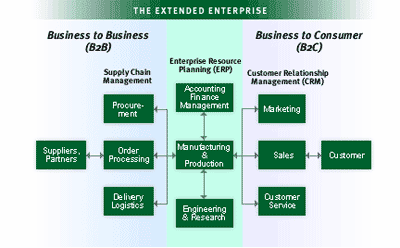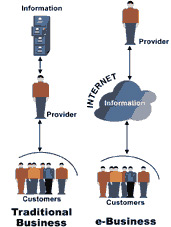The Challenge of e-Business



Concepts & Technology of e-Business
"e-Business" can be defined as the conduct of business on the Internet, not only buying and selling but also providing additional services to customers, and especially collaborating with business partners.
Many people will ask the question, "What is the difference between e-Business and e-commerce?"
E-commerce is the purchase of goods, services or other financial transactions in which the interactive process is achieved by information technology (the internet) at both ends of the interchange.
There are a number of types e-commerce:
- Business to business (B2B).
- Business to customer (B2C).
- Business to administration (B2A).
- Consumer to administration (C2A).
In particular, B2B e-commerce cuts business costs in three ways.
- It reduces procurement costs.
- It allows better supply-chain management.
- It makes possible tighter inventory control.
A typical B2C e-commerce business provides:
- A "catalogue”.
- A "shopping cart”.
- A "check out”.
- Credit card operations.
- Shipping and tracking options.

However, there are other important aspects or functions of e-Business that should be considered:
- Market Research
- Collaboration
- e-Marketing
- Banking and Financial services
- Online trading
 MARKET RESEARCH - Many companies have recognised that if they want to succeed in today's "wired world", their organisations must harness knowledge -internally and externally - in developing products, improving processes, getting closer to customers and ultimately staying ahead of competitors.
MARKET RESEARCH - Many companies have recognised that if they want to succeed in today's "wired world", their organisations must harness knowledge -internally and externally - in developing products, improving processes, getting closer to customers and ultimately staying ahead of competitors.
 Collaboration - Companies working together can use Internet technology to exploit their collective learning and knowledge.
Collaboration - Companies working together can use Internet technology to exploit their collective learning and knowledge.
This allows managers to share knowledge, collaborate more effectively and ultimately to embed organisational intelligence within processes, products and services.
 e-Marketing - e-Marketing aims to provide accurate information to a audiences that include:
e-Marketing - e-Marketing aims to provide accurate information to a audiences that include:
- Buyers trying to find products they need.
- Businesses investigating potential partners or suppliers.
- Workers searching for new employment opportunities.
- Sales offices seeking the latest product literature.
 Banking & Financial Services - Online banking allows customers to use the internet to:
Banking & Financial Services - Online banking allows customers to use the internet to:
- Check their balances,
- Print statements,
- Pay bills, and
- Transfer funds,
usually for a fraction of the cost of in-branch services.
 Banks are developing sophisticated web-based information management capabilities that:
Banks are developing sophisticated web-based information management capabilities that:
- Gain insights into customer behaviour;
- Support database marketing and modelling;
- Deepen relationships with the most profitable customers;
- Link and leverage disparate databases
A central theme is virtual customer intimacy.
 Online Trading - The emergence of direct stockbroking via automated Internet services is bringing about a significant transformation in the Australian equity market. A typical online broker will support the following activities:
Online Trading - The emergence of direct stockbroking via automated Internet services is bringing about a significant transformation in the Australian equity market. A typical online broker will support the following activities:
- The purchase and sale of shares.
- Access to share prices.
- Investment in overseas shares.
- Investment in the Money Market.
- Stock market news and research.
A major challenge of e-Business are the issues associated with:
- Security
- Protecting transactions
Currently, the major barrier to e-Business is the consumer’s lack of confidence in Internet security. For e-Business to be trustworthy, it must be secure and reliable.
Security 
Firewalls are a combination of software and hardware, which manage access between a company’s internal system and the Internet.
They are necessary where a web server has continuous access to the Internet.
Encryption can be used after your data has left your internal system.
Secure payment systems that people trust are pivotal to the continued growth of e-Business.
Credit cards are still the most common form of payment.
 However, Internet security requires policy as well as technology. A good security policy will ensure:
However, Internet security requires policy as well as technology. A good security policy will ensure:
- Safety
- Trust
- Privacy
Developing good security means combining the right technology with the appropriate security policy.
Further Challenges... 
Protecting Transactions - In any e-business an important question is:
“Who owns the transaction?”
Organisations owning the customer transaction are able to set a fee or collect a profit margin for the service provided. Therefore, owning the customer transaction has the potential to generate customer revenue for the service.
Customer Relationships - Owning the customer relationship provides i nfluence where the customer looks to the relationship holder for trust, recommendations, and specialist advice.
nfluence where the customer looks to the relationship holder for trust, recommendations, and specialist advice.
The strength of the relationship with the customer will often determine the success of the business.
Protecting Data Ownership - The key questions about data  ownership is:
ownership is:
“Who owns the data, and who has access to it for marketing?”
Information is the lifeblood of e-business. The organisations ability to identify, capture, share, and exploit the key information strongly influences business profitability.
 A Content Provider is a organisation that creates and provides content (information products or services) in digital form that is “served” to customers via third parties.
A Content Provider is a organisation that creates and provides content (information products or services) in digital form that is “served” to customers via third parties.
In general the content provider owns none of the end-customer relationship, transaction, or data.
Therefore, to be successful the content provider must be highly desirable and in demand as a supplier of content.
Difficulties faced... 
Many traditional and profitable businesses are struggling to respond to the threats and opportunities of e-business in terms of:
- Leadership
- Channel Conflict
- Cost Reduction
- Skills & Expertise
- Infrastructure
Leadership - “E-business threatens the status quo in traditional (successful) organisations.”
The leaders are often poorly prepared to make major strategic commitments necessary for e-business. Such managers are reluctant to take the initiative, preferring to wait and see.
Avoiding Channel Conflict - “Channel conflict is a real risk with e-business.”
The Internet offers a new channel to the customer, and businesses can choose to bypass existing channel partners, leading to channel conflict.
How to avoid Channel Conflict.
- Segment the channels by customer.
- Segment the channels by product.
- Refine the dealers’ role.
- Develop a new brand
- Redirect all leads to distributors
- Retreat
 Cost Reduction - An attractive feature of e-business to the potential for cost leadership offered by being able to sell goods or provide the service over the Internet at a price that is lower than that of the competition.
Cost Reduction - An attractive feature of e-business to the potential for cost leadership offered by being able to sell goods or provide the service over the Internet at a price that is lower than that of the competition.
However, many traditional organisations struggle to take advantage of, and capitalise on the lower costs available via e-business.
 Shortage of Skills & Expertise - The skills necessary for e-business initiatives are in short supply and high demand.
Shortage of Skills & Expertise - The skills necessary for e-business initiatives are in short supply and high demand.
Traditional firms struggle to offer compensation packages that compete with the extremely attractive offers of stock options for employees of dot-coms.
Infrastructure Requirements – “Infrastructure requirements for e-business are stretching the capabilities of many organisations’ IT portfolios”.
Traditional organisations are struggling with B2B e-business implementations that may require integrating their recently installed and expensive enterprise resource planning systems (ERPs) with their Web sites and the Web-sites of of partner firms.
Delivery Problems - One of the major challenges for the direct-to-customer organisation selling a physical product is getting the right product to the right address, reliably and economically.
Many innovative businesses have developed attractive Web sites, but have not developed a clear understanding of the complex logistics involved in e-business.
Multiple Business Models - The use of multiple business models across an organisation can cause confusion for customers, especially if the customer needs to adopt a variety of different business practices within the organisation.
Also, implementing more than one model can lead to other problems, including channel conflict, competency conflict, infrastructure conflict, and information conflict.
E-Business can also pose a threat to existing businesses. Need to also consider a number of questions:
“How large is the potential for competitors to undermine the loyalty of the organisation’s customers?”
 Loyalty has two important components:
Loyalty has two important components:
- Brand identification, and
- Switching costs.
“What is the difference between your organisations current geographical reach and its potential reach win the Internet?”
The larger the gap, the greater the threat or opportunity from e-business.
“What is the difference between your organisations current geographical reach and its potential reach win the Internet?”
The larger the gap, the greater the threat or opportunity from e-business.
Questions for the IT Manager…
- Who is paying for the e-Business capability? Who pays for the on-going cost?
- What return on investment (ROI) is expected? 3
- Who is driving the project? Is there intra-organisational involvement – especially from IT, marketing and sales?
- Is a Customer Relationship Management (CRM) package part of the initiative, or will it be added later?
- What level of security is needed, now and in the future?
Conclusion
The key to the development and successful operation of an e-Business initiative is involvement and cooperation within the organisation. The expertise of departments such as marketing and sales must be involved in the development. This will better ensure the project meets the strategic needs of the organisation, that it serves the business as a whole, rather than being a “special project” for the IT department.
What do you know? What do you need to know?
For reading and review quesions - this is your chance to discuss answers with your lecturer.


